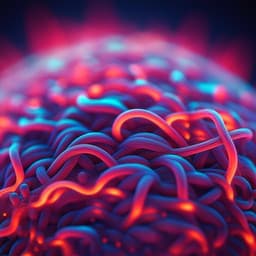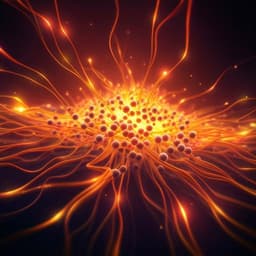
Engineering and Technology
Flexible unimodal strain sensors for human motion detection and differentiation
L. Jin, Z. Li, et al.
Discover how cutting-edge unimodal sensors utilizing piezoelectric poly L-lactic acid films can differentiate complex human motions. Conducted by a team of researchers including Lu Jin and Zhenhong Li, this study introduces innovative tension, bend, shear, and twist sensors integrated into wearable technology for enhanced motion recognition.
~3 min • Beginner • English
Introduction
The study addresses the challenge of detecting and differentiating individual mechanical stresses (tension, bend, shear, twist) in complex human joint motions using wearable sensors. Existing approaches such as camera-based motion capture and inertial sensors either require constrained environments or rigid devices and cannot resolve the individual force components contributing to motion. Conventional flexible strain sensors struggle with multimodal coupling because human joints have multiple degrees of freedom, and sensor networks needed to cover different modes can be bulky and still fail to decouple signals. The authors propose unimodal strain sensors that selectively respond to a single deformation mode and can be integrated to quantify each mode’s contribution in complex movements, enabling improved motion recognition and control.
Literature Review
Prior work in motion capture includes camera-based systems (high computational load, limited space) and inertial sensors (rigidity, limited daily-life applicability), both unable to measure individual force components. Flexible sensors (piezoelectric, resistive, capacitive, triboelectric) have advanced wearable monitoring, but most joints involve multiple DOFs leading to couplings across tension, bending, shear, and twist. Sensor networks can restrict natural movement and still cannot decouple mode contributions. Piezoelectric PLLA films are known to exhibit shear piezoelectricity due to helical molecular structure, and PVDF-based piezoelectrics exhibit normal coefficients (d31, d32, d33) making them pressure sensitive but unsuitable for unimodal decoupling by cutting. Literature has not demonstrated sensors that can detect and differentiate individual forces/stresses and their contributions within complex motions; coupling effects are typically unaddressed in sensor design and signal interpretation.
Methodology
Design and theory: The authors designed four unimodal sensors (tension, bend, shear, twist) using uniaxially drawn piezoelectric PLLA films cut at specific angles (45°, −45°, 0°, 90°) relative to the drawing direction to tailor effective piezoelectric coefficients. Mathematical modeling predicted that PLLA45 and PLLA−45 create normal coefficients (d12', d13') with opposite polarities, while PLLA0 and PLLA90 retain only shear d14 with opposite polarity. Finite element simulations (ABAQUS) evaluated piezoelectric responses under tensioning, bending, shearing, and twisting, confirming sensitivity patterns and polarity oppositions.
Unimodal sensor concept: Each unimodal sensor is a double-layer assembly of two PLLA pieces with tailored cutting angles, oriented so that matched deformations yield superimposed signals while unmatched modes cancel via polarity opposition. Specifically: tension sensor uses two PLLA45; bend sensor uses PLLA45 + PLLA−45; twist sensor uses PLLA0 + PLLA0 (configured to sum under twist); shear sensor uses PLLA0 + PLLA90. Inner patterned electrodes are sandwiched; an outer electrode coats the exposed surface and connects to ground, providing self-shielding.
Fabrication of PLLA films: PLLA (NatureWorks 4032D) extruded into films (≈70 μm thick) and drawn uniaxially at 80 °C to drawing ratios (DR) of 3.3, 3.7, 4.0, 4.5. Structural characterization via 2D/1D WAXD and DSC established α-crystal orientation increasing with DR; crystallinity reached 60.9% at DR 4.5. DR 4.5 films showed highest piezoelectric responses and were used for sensor fabrication. Polarity confirmation performed by swapping electrodes; transverse/longitudinal tests confirmed shear-only PC for base film.
Assembly: Two matched PLLA parts per sensor were cut from nearby regions of the same film to minimize parameter mismatches (cutting angle, thickness, size). The front sides of matched parts were bonded using silicone adhesive; inner electrodes connected to signal, outer electrode (silver conductive paint) connected to ground (coaxial shield).
Testing and measurements: Sensors were tested under controlled deformations: tensioning (1% strain), bending (20°), twisting (30°), shearing (0.015 shear strain). Signals acquired using a Piezo Film Lab Amplifier (10 MΩ input, 0.1–10 Hz band-pass, 0 dB gain; for shielding tests 1 GΩ, 0.1–1000 Hz). Mechanical actuation via Instron (tension/shear), custom bending and twisting machines. Stability assessed over 10,000 cycles; repeatability over days. Pressing response compared to a commercial PVDF film sensor. EM shielding performance compared between unimodal (self-shielded) and unshielded single-layer PLLA. Signal normalization placed Vp-p on 0–1 scale by dividing by the matched sensor’s Vp-p at each deformation level.
Integrated unimodal sensor (i-US): Four unimodal sensors were stacked, each channel individually shielded and read out, to detect multimodal deformations without mutual interference.
Applications and data collection: i-US integrated into a wrist sleeve (i-Sleeve) and a glove (i-Glove) for wrist and finger motion detection. For finger motion classification, two participants each performed 100 trials across seven finger modes; for air-writing, two participants each performed 100 trials writing 13 characters (U, O, M, 0–9) with predefined trajectories. Signals sampled at 100 Hz, low-pass filtered (6th-order Butterworth, 10 Hz), segmented (1 s window, 0.2 s step), transformed via FFT. A LeNet-5 based CNN with two convolutional layers trained on 80% data, tested on 20%.
Key Findings
- Unimodal specificity: Each unimodal sensor exhibited strong response only to its matched deformation (tension, bend, shear, twist) and negligible response to unmatched modes; this held across deformation levels (P < 0.001). Controls with unstretched PLLA produced negligible signals, confirming piezoelectric origin.
- Performance vs single-layer PLLA: Compared to single-layer PLLA sensors, unimodal sensors showed higher Vp-p under matched modes: tension and shear sensors approximately doubled Vp-p; bend sensor showed ~20× higher Vp-p under 20° bending; twist sensor showed ~70× higher Vp-p at 30° twist (consistent at 20° and 40°).
- Stability and repeatability: Sensors maintained stable output over 10,000 cycles and reproducible signals across days.
- Self-shielding: Unimodal sensors’ outer electrode provided effective EM and motion artifact shielding, markedly reducing 50 Hz interference and artifact compared to unshielded single-layer PLLA.
- Mode insensitivity: Unimodal sensors were insensitive to normal pressing, unlike PVDF sensors; PLLA films exhibit no pyroelectricity, and triboelectric interference in motion detection was negligible due to grounded outer electrode.
- Integrated sensing (i-US): The stacked i-US independently detected and differentiated tensioning, bending, twisting, and shearing, with channels operating without evident interference.
- Applications: i-Sleeve captured complex wrist motions, including simultaneous detection of bending, twisting, and shearing during wrist turning. i-Glove discriminated finger modes (bending up/down, shearing left/right, turning clockwise/anti-clockwise, flexion/extension) and enabled finger air-writing of 13 characters with classification accuracy of 89.4%; seven finger-motion classification achieved mean accuracy of 90.2%.
- Practical considerations: Fabrication tolerances (cutting angle, thickness, size, drawing direction) affect noise in unmatched modes; cutting matched parts from adjacent film areas mitigates mismatch.
Discussion
The work demonstrates a sensor design that inherently decouples multimodal deformation components at the material/structural level, enabling direct interpretation of individual strain contributions from electrical signals. By pairing PLLA films with tailored and opposite effective piezoelectric coefficients, matched deformations sum while unmatched ones cancel, overcoming coupling issues that hinder conventional strain sensors and large sensor networks. This decoupling allows integrated devices (i-US) to quantify complex joint motions and supports practical applications such as wrist tracking and finger air-writing. Enhanced signal amplitude relative to single-layer films, self-shielding against EM/motion artifacts, mechanical stability, and insensitivity to pressure and temperature fluctuations improve robustness for real-world use. The approach is generalizable to other piezoelectric materials if analogous coefficient tailoring and structural arrangements are feasible. These findings provide a pathway toward compact, efficient motion monitoring and control systems that require fewer sensors while delivering richer, more interpretable data.
Conclusion
The authors introduce flexible film-based unimodal piezoelectric strain sensors that selectively detect tension, bending, shear, or twist by structurally combining cut PLLA films with complementary piezoelectric responses. The integrated unimodal sensor (i-US) differentiates and quantifies individual deformation modes in complex motions. The sensors outperform single-layer PLLA in matched-mode sensitivity, offer self-shielding against EM noise and motion artifacts, show strong stability, and enable practical applications including wrist motion capture and finger air-writing with high classification accuracy. Future directions include refining fabrication to further reduce residual noise from mismatches, extending the unimodal design principle to other piezoelectric materials, scaling to multi-axis arrays and wearable platforms, integrating low-power electronics and on-device learning, and expanding user studies for broader generalization and improved motion recognition performance.
Limitations
- Fabrication sensitivity: Small mismatches in cutting angle, drawing direction, size, and thickness between paired PLLA layers can introduce residual responses (noise) under unmatched deformations (e.g., residual d14 from angle deviations). Accurately identifying drawing direction in transparent films is challenging.
- Generalizability and datasets: Application demonstrations (finger motion and air-writing) used data from only two participants, which may limit generalization; writing trajectories were constrained to standardize signals.
- Material constraints: PVDF is unsuitable for unimodal decoupling due to inherent d33, limiting material choices. PLLA-only shear piezoelectricity requires precise cutting/orientation to realize desired effective coefficients.
- System integration: Experiments used external amplifiers and controlled lab setups; real-world integration may require further miniaturization, power optimization, and robustness testing across diverse activities and environments.
Related Publications
Explore these studies to deepen your understanding of the subject.







